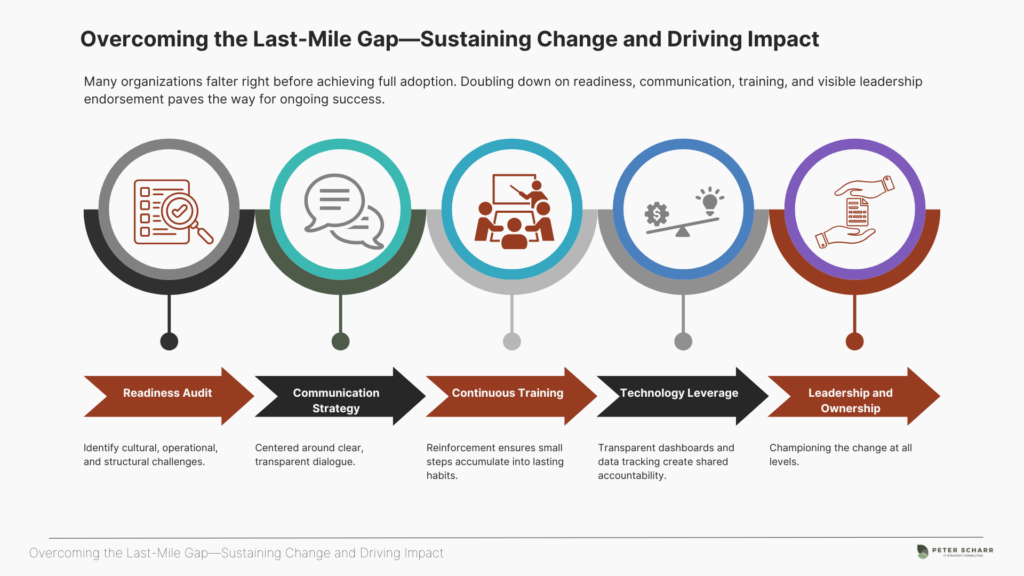The Balancing Act Between Vision and Practical Execution
Organizations often have great strategies, only to stumble right before the finish line—this stumbling block is what many refer to as the “last-mile gap.” It’s that final push where projects either live up to their potential or fade into irrelevance. Sustainable adoption ensures that teams don’t merely change once but commit to ongoing improvement, and that’s where true organizational success is born.
Unraveling the Last-Mile Gap and Why It Matters
The “last-mile gap” can be envisioned much like a meticulous painter leaving the final strokes unfinished. All the effort invested up to that point remains incomplete until the finishing touches are in place—those brushes of color that bring the entire picture to life. In the same way, effective change management efforts risk short-term impact without sustained, day-to-day adoption. This shortfall not only costs valuable resources but also undermines trust in future initiatives. Sustainable adoption, on the other hand, invests in consistent follow-through and ensures that an organization’s hard work turns into a lasting reality.
Discovering Your Readiness: Looking in the Mirror
Before a painting comes to life, a blank canvas must be prepped correctly. Similarly, organizations need to evaluate their readiness for change by identifying operational, cultural, and structural barriers. Perhaps there’s a legacy system that makes integration difficult or a widespread preference for old workflows. A thorough readiness assessment lays out potential stumbling blocks, allowing leadership to take proactive steps. This process often includes surveys, focus group discussions, or guided audits that shine a light on the real level of preparedness. According to McKinsey’s findings, organizations that take the time to analyze their hurdles in advance stand a significantly better chance of implementing changes seamlessly.

Telling the Story: Engaging Communication for True Alignment
Compelling communication is like the chisel in a sculptor’s hand—without it, shaping an intricate piece becomes impossible. Similarly, well-crafted messaging helps stakeholders understand the “why” behind any change. Leaders who share transparent updates—both the successes and the lessons learned—earn trust and inspire participation from all corners of the organization. Effective communication strategies include:
- A strong, relatable narrative that connects change goals to employee aspirations
- Regular updates via diverse channels (email, internal blogs, quick team huddles)
- Opportunities for open dialogue, where questions and concerns can be addressed directly
Keeping the Beat Alive: Ongoing Training as Reinforcement
No successful orchestra can thrive without constant practice and rehearsal. In an organizational setting, continuous training ensures that skills are not only learned but also reinforced. A one-off training session might provide the initial spark, yet ongoing support—workshops, microlearning courses, or refresher sessions—keeps the flame burning. This consistent approach helps employees internalize new protocols, making them second nature instead of a short-lived initiative.
Shining a Light on Progress: Transparent Tech Tools
Technology can reveal an initiative’s daily progress just as a gallery spotlight showcases the delicate textures of an artwork. Dashboards and digital tracking tools not only generate real-time data but also keep every stakeholder in the loop. Transparent reporting fosters accountability, enabling leaders to spot problems early on and driving employees to meet and exceed expectations. By visually displaying metrics, the entire organization gains a shared sense of accomplishment as milestones are met. A Deloitte study even shows that organizations leveraging transparent digital solutions report higher rates of stakeholder engagement, reinforcing the importance of open information.
Leading from the Front: Leadership Engagement for Authentic Buy-In
No sculpture can be completed without someone envisioning its final form. In the same way, leaders must model the behavior they expect to see in their teams. By publicly endorsing new processes—adopting them first and openly celebrating incremental progress—leaders create a culture where change is not only accepted but championed. Grassroots involvement from employees likewise fosters ownership. When people at every level are actively engaged, an initiative becomes more than management’s idea; it evolves into a shared commitment across the organization.
Learning from a Global Conglomerate’s Transformation
Consider a multinational manufacturing corporation that struggled to implement a new quality-control system. Initial adoption was quick, but old habits resurfaced once internal audits slowed. Only after integrating regular training modules and weekly digital dashboards did the company see consistent improvement. The last-mile gap was finally bridged when senior leadership acknowledged ongoing challenges and made a visible commitment to chart and share progress, one step at a time.
Training Triumphs in Real-World Implementation
A software solutions provider faced an uphill battle introducing a new client management platform. Employees completed a mandatory course, but efficiency gains remained elusive. The turnaround came with a rollout of short, continuous learning videos accessible on-demand. Department managers noticed immediate improvements when staff could revisit the training at their own pace. Credible reinforcement over time meant skill retention soared, turning a lackluster debut into a lasting success story.
Small to Mighty: Insights from Mid-Scale Ventures
Adoption challenges aren’t limited to giants. A mid-sized e-commerce firm experienced employee burnout after unexpectedly fast growth. The key to survival was a streamlined change management approach—mapping potential bottlenecks, communicating openly about the benefits of new inventory systems, and encouraging regular feedback. Although the size of the company was smaller, the principles of readiness, communication, and reinforcement remained the same, yielding impressive, ongoing results.
Closing Thoughts on Steadfast Transformation
Securing organizational change requires hitting that critical “last mile” where readiness, communication, training, technology, and leadership intersect. The tactics discussed here—clear messaging, continuous skill-building, strategic use of progress-tracking tools, and active stakeholder engagement—all combine to reduce resistance and anchor new behaviors permanently. When followed conscientiously, these measures can transform what might otherwise be a fleeting success into a powerful, long-term triumph.
Thank you for reading and embarking on this journey toward meaningful, enduring organizational change.
A bold new step forward,


